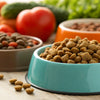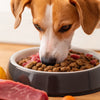What Is Dog Food Kibble? Understanding the Basics and Benefits
- Houndsy
Table of Contents
- Introduction
- What Is Kibble?
- How Is Kibble Made?
- The Benefits of Feeding Kibble
- Choosing the Right Kibble
- Enhancing the Kibble Feeding Experience with Houndsy
- Conclusion
Introduction
Did you know that approximately 60% of dog owners in the United States choose dry kibble as their dog’s primary food source? This statistic alone highlights the widespread popularity and reliance on kibble among pet owners. But what exactly is dog food kibble, and why has it become such a staple in our canine companions' diets?
Kibble is not just a convenient form of dog food; it represents an evolution in how we feed our pets, blending nutrition, convenience, and affordability. In this blog post, we will explore the origins of kibble, its ingredients, production processes, and the benefits it offers for our furry friends. We aim to provide you with a comprehensive understanding of kibble so you can make informed decisions for your pet’s diet.
Throughout this article, we will also reflect on how the Houndsy Kibble Dispenser can enhance the feeding experience, turning meal times into a seamless and enjoyable ritual for both you and your dog. By the end of this post, you will have a clearer picture of what kibble is and how it can be part of a balanced diet for your beloved pet.
What Is Kibble?
Kibble, often referred to as dry dog food, is a type of dog food that consists of small, dry pieces of highly processed food made primarily from a blend of meat, grains, vegetables, and other ingredients. The key characteristic of kibble is that it is shelf-stable, meaning it can be stored for long periods without spoiling, making it a practical choice for pet owners.
The Composition of Kibble
Understanding what goes into kibble is essential for making informed feeding decisions. Here are the primary components typically found in kibble:
- Proteins: Kibble often contains meat, poultry, or fish as its primary protein source. These proteins are crucial for your dog’s muscle development and overall health.
- Grains and Carbohydrates: Many kibble varieties include grains such as rice, corn, or barley, which provide energy and fiber. However, some pet owners opt for grain-free options due to dietary sensitivities in their dogs.
- Vegetables: Ingredients like peas, carrots, and sweet potatoes can offer vitamins and minerals, contributing to a balanced diet.
- Fats: Healthy fats are included to provide essential fatty acids that help maintain a shiny coat and healthy skin.
- Vitamins and Minerals: Most kibble formulations are fortified with essential vitamins and minerals to ensure complete and balanced nutrition.
Nutritional Value
The nutritional value of kibble is an important factor to consider. Quality kibble is designed to meet the dietary needs of dogs at various life stages, from puppies to seniors. It typically contains a balanced ratio of proteins, fats, and carbohydrates, along with added vitamins and minerals.
How Is Kibble Made?
The production of kibble involves a process known as extrusion, which combines cooking and shaping the ingredients into the familiar bite-sized pieces we see in bags. Here’s a detailed look at how kibble is made:
- Ingredient Mixing: The first step involves mixing the raw ingredients, including meats, grains, and vegetables, into a homogeneous blend. This mixture is often ground into a flour-like consistency.
- Cooking: The blended ingredients are subjected to high temperatures and pressures in an extruder. This cooking process helps eliminate harmful bacteria and pathogens, ensuring the safety of the food.
- Shaping: As the cooked mixture exits the extruder, it is forced through a die, which shapes it into the desired kibble size. The mixture is then cut into small pieces by sharp blades.
- Drying: After shaping, the kibble is dried to reduce moisture content, enhancing shelf stability. This step is crucial for preventing spoilage.
- Coating: Many kibble brands will coat the kibble with fats and flavor enhancers after drying to improve palatability. This makes the kibble more appealing to dogs.
- Packaging: Finally, the kibble is packaged in bags and distributed to retailers for pet owners to purchase.
This extrusion process not only ensures that kibble is convenient and cost-effective but also allows for a long shelf life without the need for artificial preservatives.
The Benefits of Feeding Kibble
Kibble has several advantages that make it a popular choice among pet owners. Here are some key benefits:
Convenience and Cost-Effectiveness
One of the most significant advantages of kibble is its convenience. Kibble is easy to store, measure, and serve, making it a practical option for busy pet owners. Additionally, purchasing kibble in bulk can often be more economical than buying wet food or raw ingredients.
Long Shelf Life
Kibble’s low moisture content means it can be stored for extended periods without spoiling. This is beneficial for pet owners who may not have the time to shop for fresh food regularly.
Less Messy
Unlike wet dog food, which can be messier and require refrigeration, kibble is generally less messy. It can be left out for longer periods without the worry of spoilage, making it ideal for households with young children or multiple pets.
Dental Health
Chewing kibble can help promote dental health by reducing plaque and tartar buildup. The crunchiness of the kibble acts as a mechanical cleaner for your dog’s teeth, promoting healthier gums and fresher breath.
Nutritional Balance
When formulated correctly, kibble can provide a complete and balanced diet for dogs. High-quality brands ensure that the kibble contains all the necessary nutrients, vitamins, and minerals your dog needs to thrive.
Choosing the Right Kibble
With so many options available, selecting the right kibble for your dog can be overwhelming. Here are some tips to help you make an informed choice:
- Read the Ingredient List: Look for high-quality protein sources at the top of the ingredient list. Avoid products that list vague terms like "meat by-products" or "animal meal."
- Check for Nutritional Adequacy: Ensure that the kibble meets the standards set by the Association of American Feed Control Officials (AAFCO) for complete and balanced nutrition.
- Consider Your Dog’s Needs: Take into account your dog’s age, size, activity level, and any specific dietary needs. There are specialized formulas for puppies, seniors, and dogs with food sensitivities.
- Consult Your Veterinarian: If you’re unsure about which kibble is best for your dog, consult your veterinarian for personalized recommendations.
Enhancing the Kibble Feeding Experience with Houndsy
At Houndsy, we believe that feeding time should be a joyful experience for both dogs and their owners. That’s why we designed the Houndsy Kibble Dispenser. This innovative product combines functionality with mid-century modern design, offering a beautiful addition to your home decor while simplifying the feeding process.
Key Features of the Houndsy Kibble Dispenser
- Convenient Crank Mechanism: Our dispenser features a standing-height crank, allowing you to dispense kibble without bending over. This ergonomic design enhances your feeding routine by reducing strain on your back.
- Perfect Portion Control: The Houndsy Kibble Dispenser delivers precise portions every time, ensuring that your dog receives the right amount of food without the hassle of measuring.
- Large Capacity and Freshness: With a storage capacity of 25 to 30 pounds, our dispenser can hold a substantial amount of kibble. The BPA-free liner helps maintain freshness, so your dog enjoys every meal.
- Pet-Proof Design: The auto-locking mechanism prevents accidental dispensing by curious pets or toddlers, ensuring that feeding time remains safe and mess-free.
Investing in a Houndsy Kibble Dispenser not only streamlines your dog’s feeding routine but also elevates the entire experience, making it a beautiful ritual to share with your pet.
Conclusion
Kibble is more than just dog food; it represents a blend of nutrition, convenience, and practicality that fits seamlessly into our busy lives as pet owners. By understanding what kibble is, how it’s made, and the benefits it offers, we can make informed decisions about our dogs' diets.
As we strive to enhance the feeding experience, the Houndsy Kibble Dispenser stands out as an innovative solution that combines function and design. We invite you to explore how the Houndsy Kibble Dispenser can transform your dog’s mealtime into a delightful ritual.
FAQs
1. Is kibble the best choice for my dog?
Kibble can be a good choice as it provides balanced nutrition and is convenient to use. However, it’s essential to select high-quality kibble that meets your dog’s specific needs.
2. Can I mix kibble with wet food?
Yes! Mixing kibble with wet food can provide variety in texture and flavor, making mealtime more enjoyable for your dog.
3. How much kibble should I feed my dog?
The amount of kibble depends on your dog’s age, weight, and activity level. Always follow the feeding guidelines on the kibble packaging and consult your veterinarian for personalized advice.
4. How can I store kibble to maintain freshness?
Store kibble in a cool, dry place, preferably in an airtight container. The Houndsy Kibble Dispenser is an excellent way to keep kibble fresh and easily accessible.
5. What should I do if my dog is not eating kibble?
If your dog refuses kibble, consider trying different flavors or brands. You can also mix in wet food or toppers to enhance the appeal. If the problem persists, consult your veterinarian for advice.













